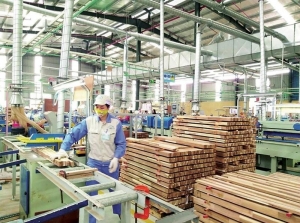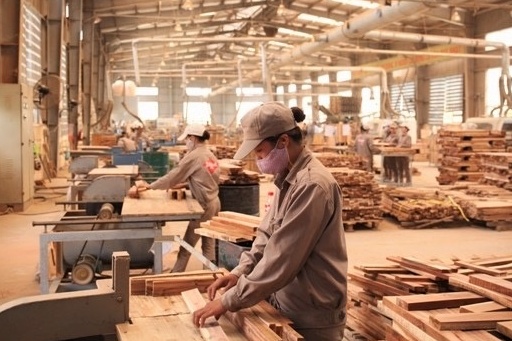New solutions needed for wood and timber industry
 |
Le Hoang Tai, deputy director of the Vietnam Trade Promotion Agency (Vietrade) under the Ministry of Industry and Trade, said, "Vietnam's wood and timber products are considered a key export product group, and they make a significant contribution to the country's overall export turnover."
Tai shared data from the General Department of Customs that showed Vietnam's export value of timber and wood products in June was $1.09 billion, a decrease of 30 per cent on-year. Overall exports of wood and timber products for the first half of 2023 were estimated at $6.06 billion, down 28 per cent on-year.
According to Pham Phu Ngoc Trai, chairman of Global Integration Business Consultants (GIBC), the current shortfall in orders will be temporary.
"Vietnam's furniture industry has tremendous potential for development over the next 5 to 10 years. The world’s furniture industry is growing at a compound annual growth rate (CAGR) of 4.5 per cent, meanwhile, Vietnam's wood processing industry is growing with a CAGR of 15.4 per cent. This is testament to the industry's great potential," said Trai.
"However, Vietnamese businesses will face new challenges, such as the EU's Carbon Border Adjustment Mechanism (CBAM)," Trai added.
The CBAM will take effect on October 1 of this year, and will see certain goods exported to the EU incur additional costs unless evidence can be shown of emissions from the production process being offset by carbon credits.
“The carbon credit market is an opportunity for Vietnamese businesses to increase their competitive edge. In the meantime, Vietnam's wood and timber industry needs to reposition its goals to become a green and sustainable hub for the world,” said Trai.
Besides these challenges, many Vietnamese businesses have failed to diversify their export markets. The US currently accounts for 30 per cent of export orders for Vietnam's wood and timber products, leaving the industry susceptible to a damaging blow when American buyers scale down orders, as they have done amidst the country's cost of living crisis.
Nguyen Quoc Khanh, chairman of the Handicraft and Wood Industry Association of Ho Chi Minh City (HAWA), said, "It is the right time for businesses to overhaul their strategies by building a lean system and finding new markets amid the market slowdown."
"For instance, large Vietnamese furniture brands have expanded their presence in new markets with great potential, especially in super-rich countries in the Middle East like Saudi Arabia and the UAE, to supply products for mega-property projects," Khanh added.
In addition, many trading programmes have been actively revamped to both enhance business efficiency and raise global awareness of quality made-in-Vietnam furniture. Among these is the HAWA Expo, which has announced its upcoming event for 2024.
At the 2023 HAWA Expo, businesses signed 64 contracts and cooperation minutes with orders worth $3.6 million. Next year, the HAWA Expo, along with local wood and timber associations, are looking forward to scaling up proceedings.
"By 2024, we will have tripled the scale of HAWA Expo with the participation of 700 exhibitors and 3,000 booths," said Khanh.
Taking place from March 6 to 9, next year, the 2024 HAWA Expo is expected to draw many industry players interested in the huge number of foreign buyers and visitors to the exhibition, which is expected to attract over 30,000 people.
The exhibition will also feature new segments, including interior design, decorative products, and project contractors in the fields of tourism, restaurants, and hotels. Furthermore, it will be the first event extending the show to three different locations, spanning from Ho Chi Minh City to Binh Duong. These initiatives aim to cover the entire supply chain of Vietnam’s furniture sector to promote the image of the industry in the eyes of international buyers.
According to the report by Statista, the global market value of furniture was estimated to be $557 billion in 2022 and is expected to increase every year to reach a forecasted value of approximately $650 billion by 2027. Vietnam currently supplies just 9 per cent of the global demand, indicating ample room for development.
 | Strengthening Vietnam's wood industry Vietnam is working to establish a legal supply chain to become a global leader in the processing and export of wood. |
 | Wood industry striving to regain growth momentum Having undergone numerous hardships, businesses in the wood industry are showing great resilience with a high level of adaption and flexibility to regain their growth momentum. |
 | Furniture export orders return but requirements higher While the demand for export markets remains low, the timber industry must increase its competitiveness to remain viable. |
What the stars mean:
★ Poor ★ ★ Promising ★★★ Good ★★★★ Very good ★★★★★ Exceptional
 Tag:
Tag:
Related Contents
Latest News
More News
- Vietnam and Switzerland conclude SwissTrade (December 17, 2025 | 18:22)
- TECHFEST Vietnam 2025 links startups with policy and capital (December 15, 2025 | 18:21)
- MST to allocate $3.8 billion for sci-tech in 2026 (December 15, 2025 | 18:10)
- Long Thanh International Airport welcomes first Vietnam Airlines test flight (December 15, 2025 | 18:01)
- Health Innovation Hub: accelerating health equity through digital healthcare innovation (December 15, 2025 | 08:00)
- Vietnam’s first AI Law to take effect from March 2026 (December 12, 2025 | 09:00)
- Chi Communications joins SEA CAN alliance (December 11, 2025 | 17:39)
- New Law on High Technology sets incentives and safeguards (December 11, 2025 | 09:00)
- IBTE 2025 to return to Ho Chi Minh City this December (December 11, 2025 | 09:00)
- Masan posts steady gains as Vietnam targets stronger retail growth (December 10, 2025 | 18:58)























 Mobile Version
Mobile Version